Weymouth pine: description of varieties and growing rules
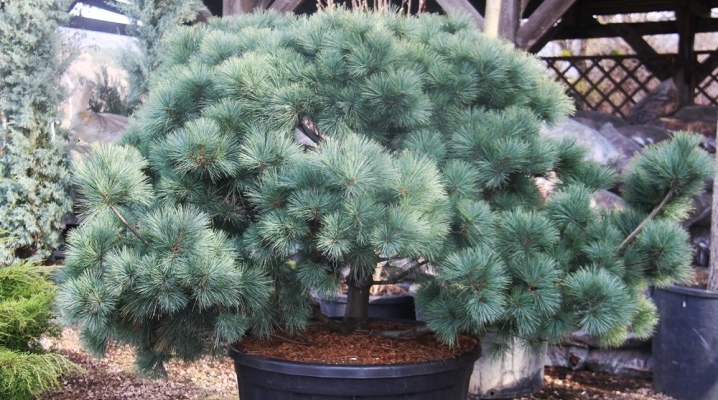
In recent years, conifers, namely pines, are gaining popularity among gardeners, owners of summer cottages, landscape designers. There are more than 100 types of pines: common, Weymouth, black, mountain, cedar, Siberian and many others. But most often on the sites you can find varieties of Weymouth pine.

Description of the species
Weymouth pine (aka white) is a fairly common species. This tree came to Europe from North America in 1705. This event happened thanks to the efforts of Weymouth, a famous English explorer. She came to Russia a little later - in 1793. At home, this tree grows on moist sandy soils. There have been cases when these trees were found in mountainous areas.
It is noteworthy that such finds happened at high altitudes: up to one and a half thousand meters above sea level.
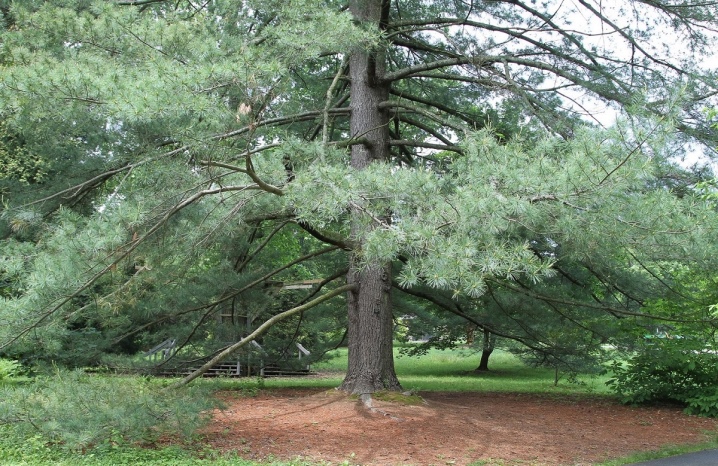
When young, this tree grows very quickly. During the first 30–40 years of life, it usually grows to a height of 20 meters. Subsequently, its growth is significantly reduced, reaching a maximum mark of 80 meters with a barrel diameter of about 1.8 meters. Most trees of this species reach a height of 40 meters, and the diameter of the trunk itself can exceed the mark of 50-60 cm.
Weymouth pine is a long-liver, it can easily live up to 4 centuries.
The correct conical shape of the crown in young animals becomes more spreading and rounded over time.


Light gray bark of a young tree, tender, smooth, after the age of 30 it becomes darker (even with a purple tint), rough with longitudinal veins-cracks. Thin and long bluish-green 10-centimeter needles grow in bunches of 5 pieces. Each needle lives for three years, after which it falls off, and a new one grows in its place.
Varieties with silvery and golden needles have been bred, and some can change color throughout the year.
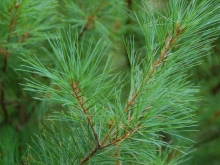

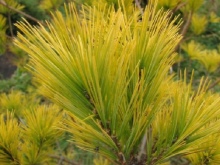
Weymouth pine is a dioecious tree, since there are both female and male cones on the same plant. Female dark brown cones growing in clusters are rather large - 15–20 cm. Male yellow cones filled with pollen are small - only 10-15 mm. All cones are similar to spruce, have an elongated shape and soft scales. In the 2nd year after pollination, reddish nut seeds with small wings begin to ripen on these cones in September. Flowering of white eastern pine can begin in early April and end in May in trees that have reached 20-25 years of age.


Varieties
There are many varieties of Weymouth pine.
"Radiata"
A very popular variety of white pine. This tree does not grow taller than 4 meters. The popularity of this variety is due to the unpretentiousness of the plant: it can grow on any soil, withstands partial shade and open sun, is not afraid of strong frosts, winds, snow drifts.
"Radiata" allows you to shape the crown by trimming.

"Minima"
A creeping dwarf shrub that grows 1.5 m in width and up to 1 m in height. This is a very beautiful variety, suitable for any corner of the site. The needles of this pine are thin, short, tough, changing their color from lemon green in spring to turquoise by the end of summer. "Minima" can withstand severe frosts, which allows it to be grown in the northern regions. The disadvantages of this variety are sensitivity to contaminated environments and instability to rust.
In the spring, the needles of the Weymouth pine can fade, so it is necessary to shade it from the bright sun.

"Pendula"
An original variety with a bizarre silhouette. Pine branches, covered with bluish-green dense needles, grow asymmetrically, hang, spread along the ground. "Pendula" grows very quickly, reaching 4 meters in height.
This pine variety should be planted in well-lit areas with alkaline, drained soil.

"Makopin"
A shrub variety that can be classified as a slow-growing variety, characterized by relatively large 20-centimeter cones and a bluish color of needles. This pine tree does not grow taller than two meters.
The Makopin variety does not tolerate the scorching sun, drought and moisture stagnation, so it should be planted in the shade, keeping an eye on soil moisture.

"Fastigiata"
One of the most unpretentious varieties of Weymouth pine. It is able to grow on any soil, under any conditions, withstanding drought, frost, air pollution. Fastigiata grows very quickly, reaching a height of 15 meters.
Remarkable is the columnar shape of this pine with emerald needles.

"Blue Sheg"
It is a dwarf and very fast growing variety, not exceeding one and a half meters in height. "Blue Sheg" has a dense spherical crown of bluish-green color.
Representatives of this variety are unpretentious, grow well in open sunny spaces, withstand severe frosts, but at the same time suffer greatly from dry weather, are easily affected by blistering rust.
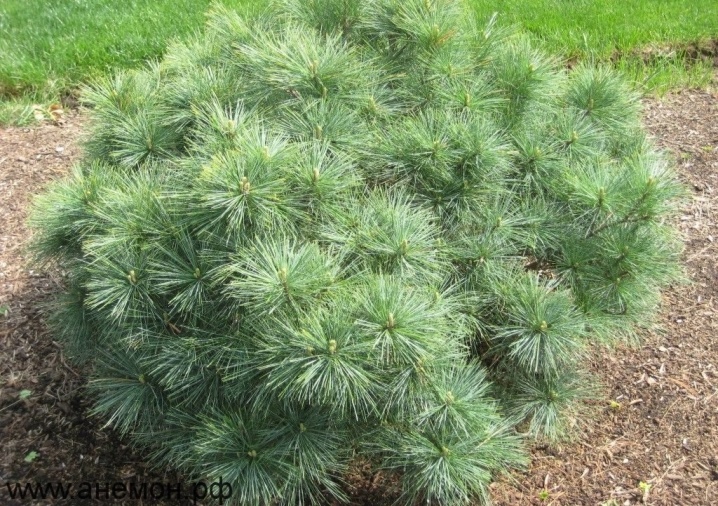
"Teeny curls"
A relatively new variety of white pine. It is attractive with long soft, beautifully curled needles of a silvery color, reminiscent of curls. This variety grows up to 3 meters in height.
It is unpretentious, withstands very low temperatures.
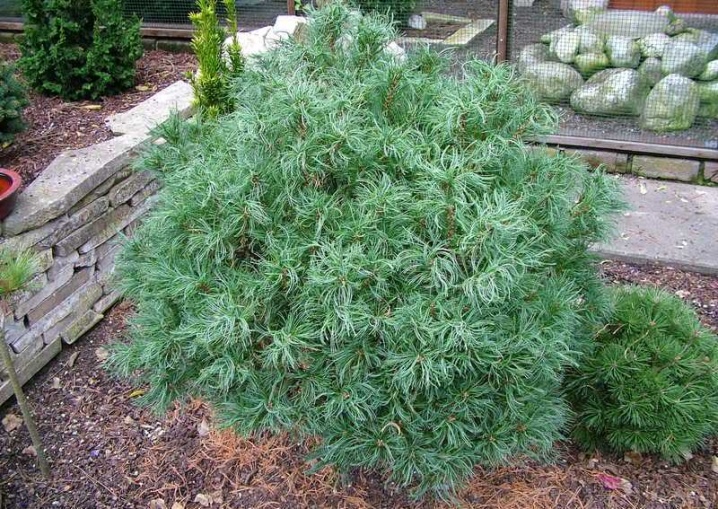
"Nana"
Slow growing variety, reaching 3 meters. The average annual height is 5 centimeters. The crown of this pine is bluish-green in color.
This pine prefers fertile, acidic and light soils.
It can grow in both sunny and shady areas, and also suffers greatly from drought.
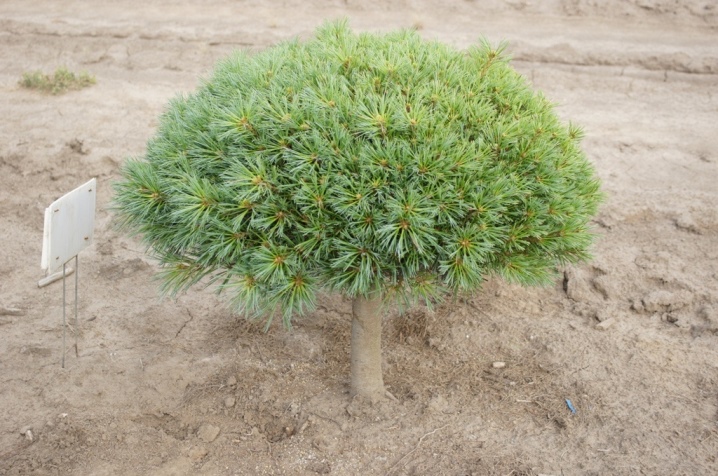
Green Curls
An unusual pine tree with a flat shape and curved needles. This species grows extremely slowly, reaching one and a half meters in height. The needles of blue-green color form curls.
The plant is unpretentious, loves sunny places, but it grows in partial shade.
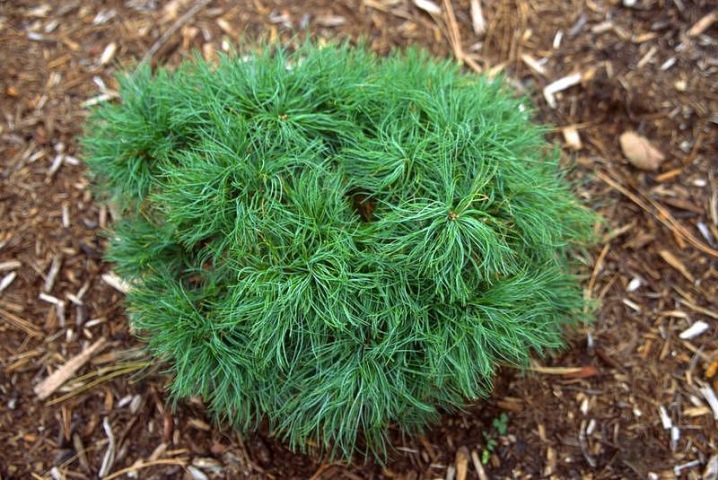
Louis
A very beautiful tall variety with unusual golden-green needles. These golden six-meter giants have a conical crown that requires pinching.
Pine should be planted in a well-lit place, to prevent the soil from drying out.
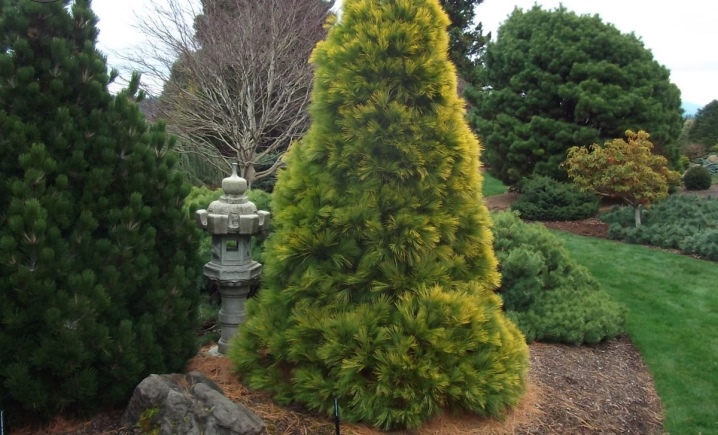
"Kruger midget"
A miniature variety with asymmetrically spaced shoots, reaches 1000 cm in height and 1500 cm in diameter. The needles are blue.
The plant is very demanding: it easily gets sick with chlorosis, does not tolerate heat, as a result of which this pine tree should be planted in carefully prepared, humus-rich soil in shaded cool places with high humidity.
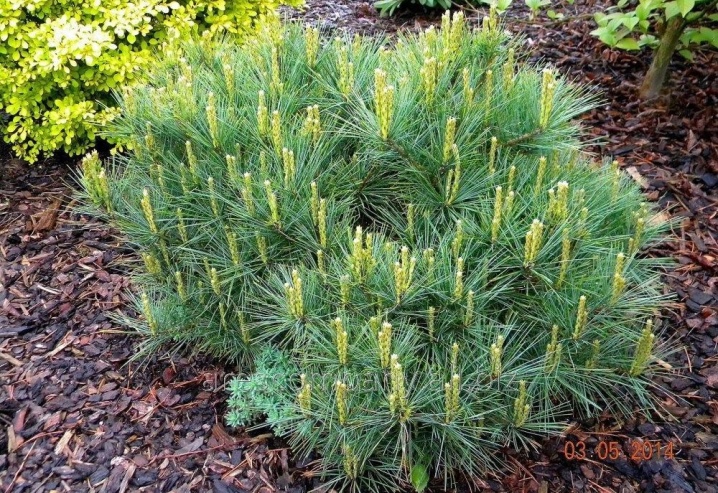
"Ontario"
A tall Weymouth pine variety that can be grown on a trunk using timely pruning. It has a perfectly flat trunk, a dark green crown in the shape of a rounded cone. The height of an adult tree is 30 meters.
It does not tolerate long frosts, prefers loamy and sandy loam soils.
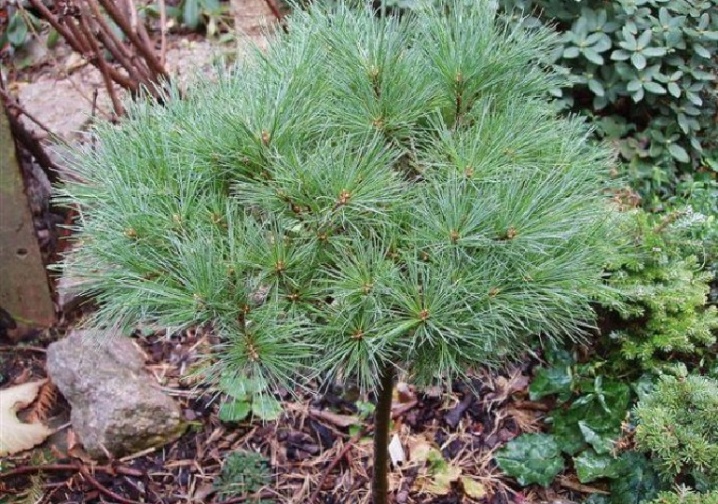
"Minute"
A highly decorative dwarf variety that grows extremely slowly. It attracts attention with its low length (up to 20 cm) and soft silvery-green needles. In 10 years it reaches a height of 60 cm.
This pine variety suffers from wind and snow, so it needs to be covered for the winter.
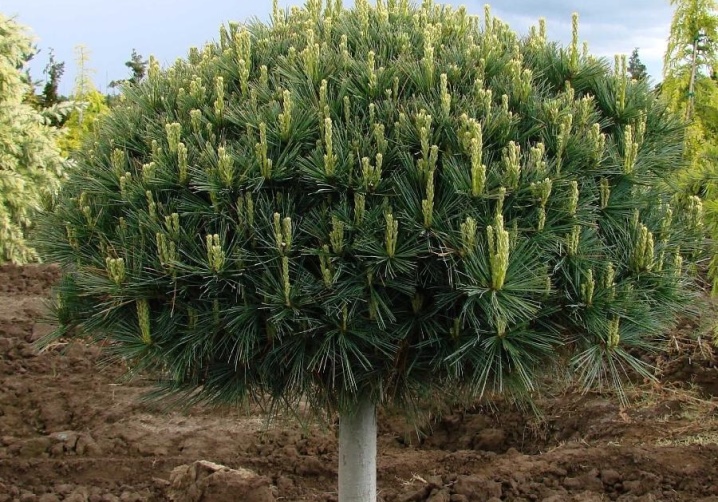
Landing features
Worth sticking to the following tips when landing:
- when you buy a seedling, do not forget to pay attention to the color of the needles: it should be rich, uniform, without any inclusions of rust; the base of the cutting should not be dry;
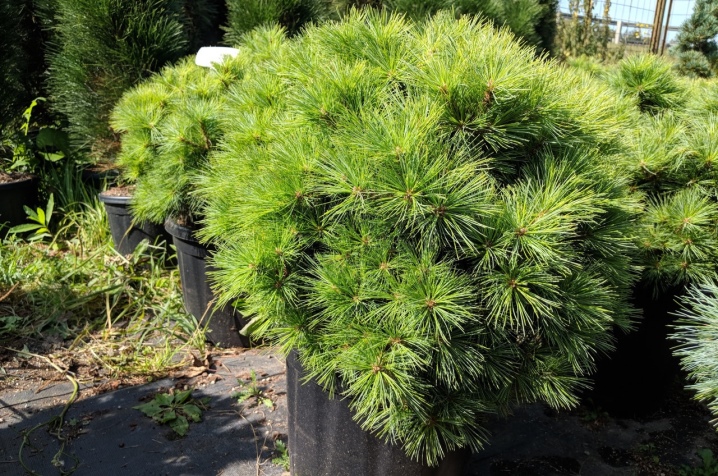
- an equally important factor is the choice of a place for planting your tree; it must be selected in accordance with the requirements of a particular variety of white pine;
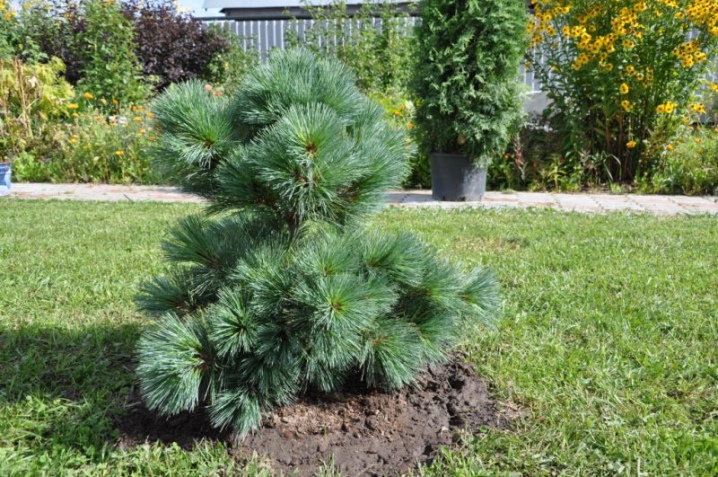
- if you plan to plant several trees, do not forget to take into account that you need to leave a distance of about 3 m between them;
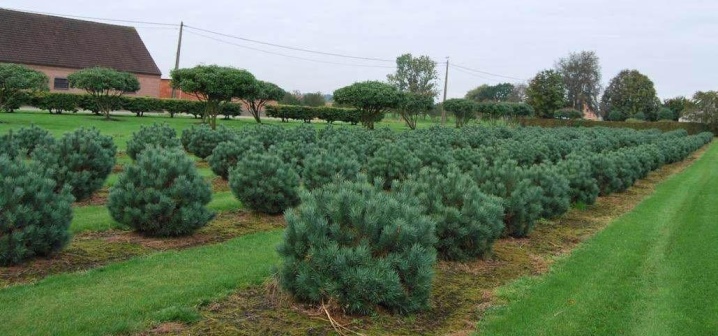
- the volume of the planting hole you dug should be approximately twice the volume of the pine root system;

- it is especially important not to forget about the presence of drainage at the bottom of the pit; at your discretion, you can use brick chips, expanded clay or pebbles;
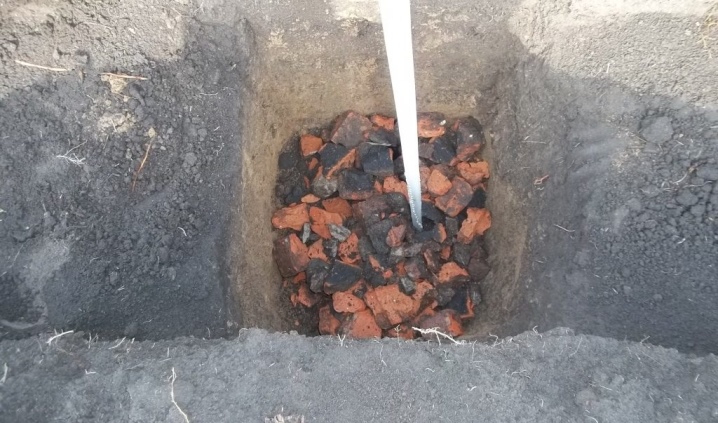
- to make a soil mixture for a future tree, you need to take sand and soddy soil in a 1: 2 ratio (if your site is with a clay type of soil) or clay and soddy soil in the same ratio (if the soil type of your site is sandy);
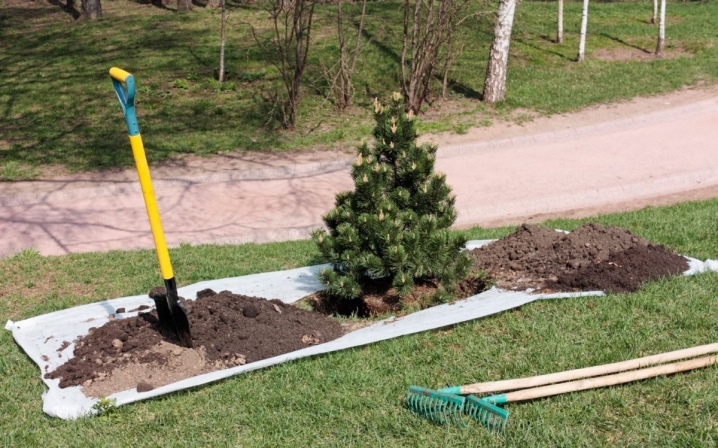
- when planting seedlings, you need to ensure that the root collar of the tree is located approximately at the level of the soil;
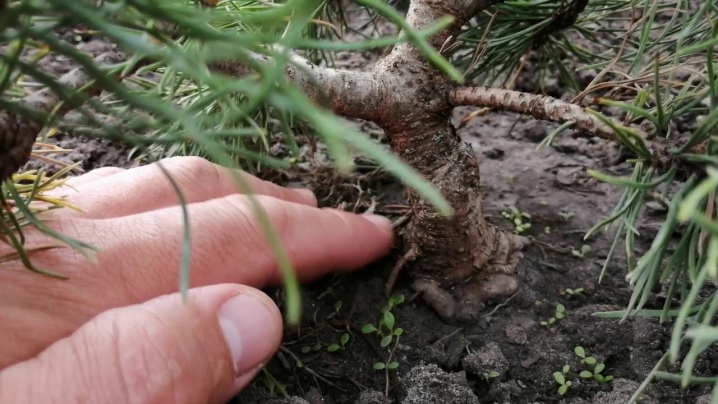
- tamp the earth around the tree, and then water well and mulch with straw, sawdust or chopped bark;
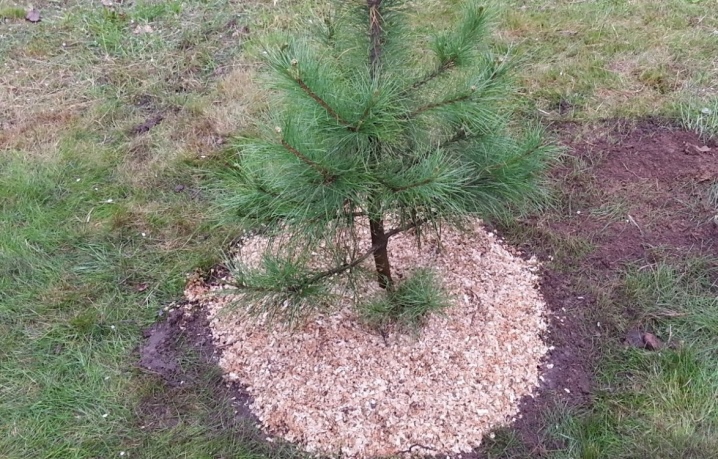
Care rules
Although the Weymouth pine can be ranked as a rather unpretentious and undemanding type of tree, some care rules must be followed. If you want to admire a healthy, strong, beautiful plant, you cannot let its growth and development take its course.
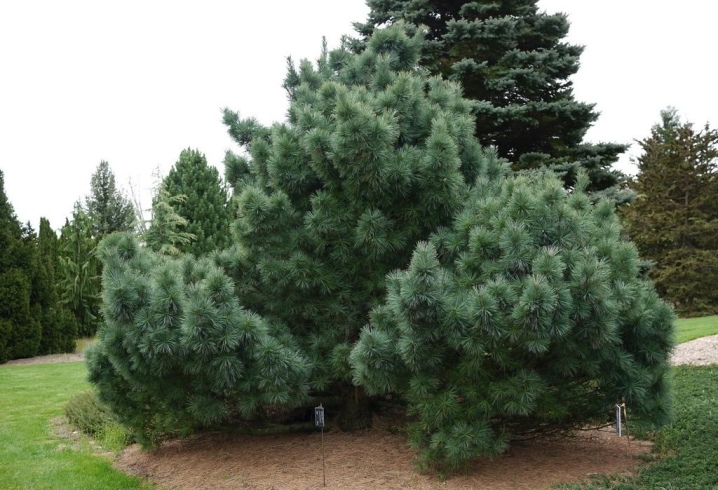
You must constantly look after the tree by performing several actions.
Watering trees
A young plant should be watered at intervals of 2-3 weeks, while consuming about 12-15 liters of water. If the summer is hot, and the sandy soil on which the tree is planted dries quickly, then watering can be done a little more often, preferably by spraying water with a hose.
It is worth noting that mature pines will grow well without watering.
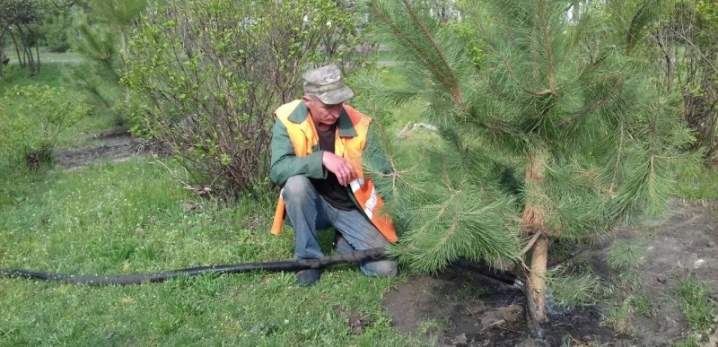
Loosening the soil
Before watering procedures, as well as when the soil is compacted, it will need to be loosened a little. This will noticeably improve the access of oxygen and nutrients to the roots of the tree.
When the tree is still young, such actions are especially necessary, because the young plant needs nutrients and oxygen most of all.
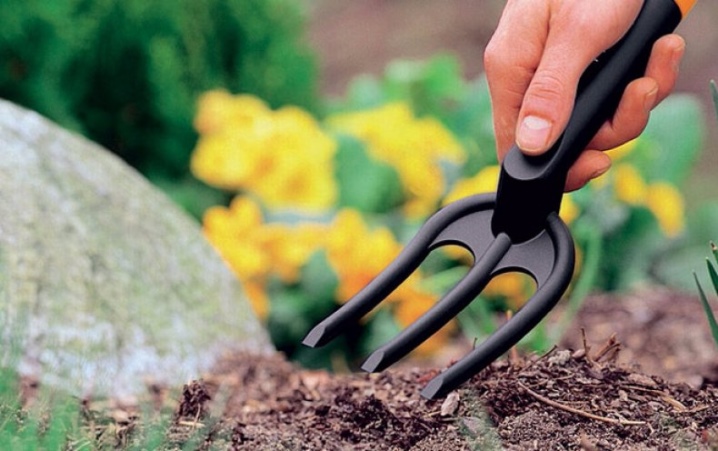
Mulching
After loosening, the soil must be mulched. This will prevent the earthen coma from drying out quickly, as well as enrich it with nutrients.
You can use sawdust or regular straw as mulch. And also well suited: crushed bark, peat, fallen coniferous needles, rotted leaves.
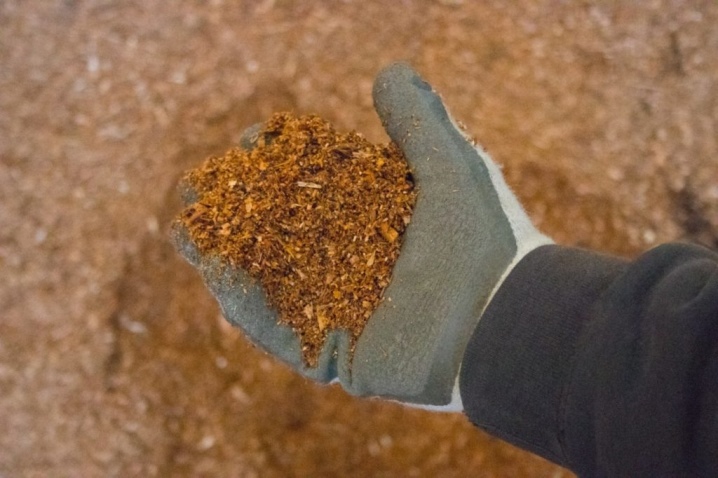
Top dressing
Pine is fed for the first few years, using special fertilizers for conifers or nitroammofosk. Mature trees generally do not need fertilization.
Young plants need fertilization to maintain the growth and external beauty of the tree (for example, a beautiful crown).
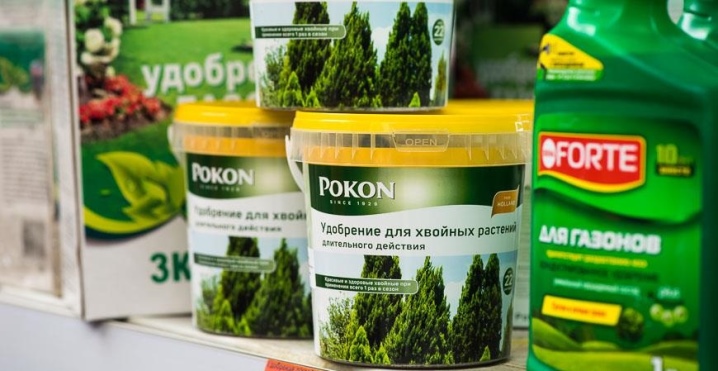
Tree pruning
Weymouth pine pruning can be done from April to October using a disinfected tool. Sanitary pruning is done when diseased or broken twigs need to be removed. Rejuvenating pruning is often done on older trees where bare and dry branches need to be removed to stimulate the growth of new young shoots. Decorative pruning is carried out only to give the desired shape to the crown of the tree: pyramidal, spherical, conical, on a trunk.
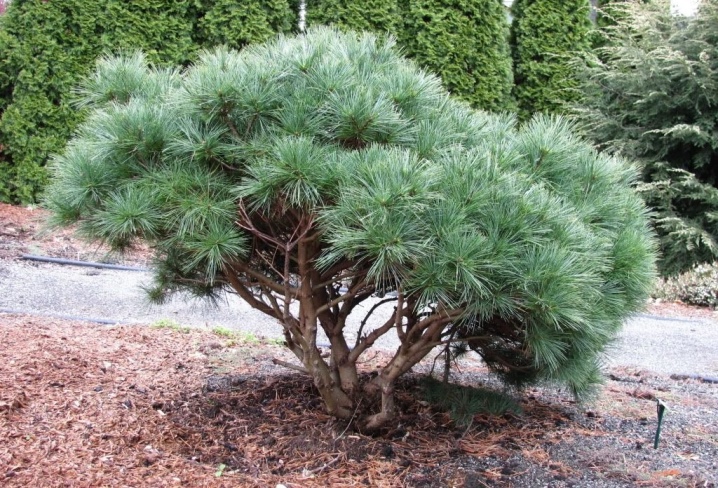
Shelter for the winter
Regardless of the variety, any pine seedling in the early years requires shelter for the winter. This is one of the most important factors, because almost everyone faces problems during wintering.
You can use both ordinary spruce branches and burlap stuffed with straw for shelter.
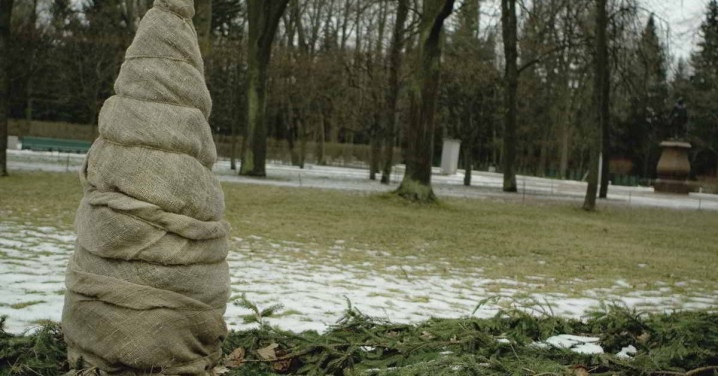
Possible diseases and pests
There are two of the most common diseases of the eastern white pine.
Blister rust
When this disease is affected, orange bubbles form on the branches, growing into whole growths. Resin flows out of the cracks in the bark, the shoots dry out.
To treat a tree, it is necessary to treat it with fungicides, cut out damaged branches.
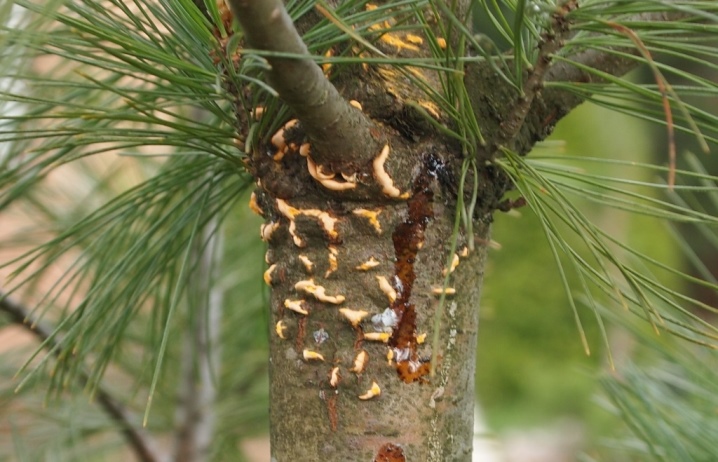
Shoot cancer
The needles turn yellow, turn brown and dry, buds die off, non-healing ulcers form on the bark.
Treatment consists of removing infected shoots, bark and spraying with copper-containing preparations.
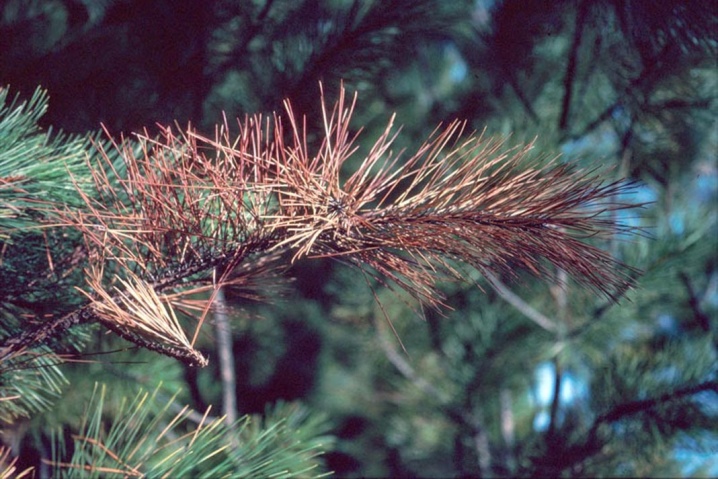
If you are faced with such diseases, and not with a simple raid of pests, then the most important thing is to diagnose the disease in time. Starting the process "on its own" under these circumstances can turn into death for the pine.
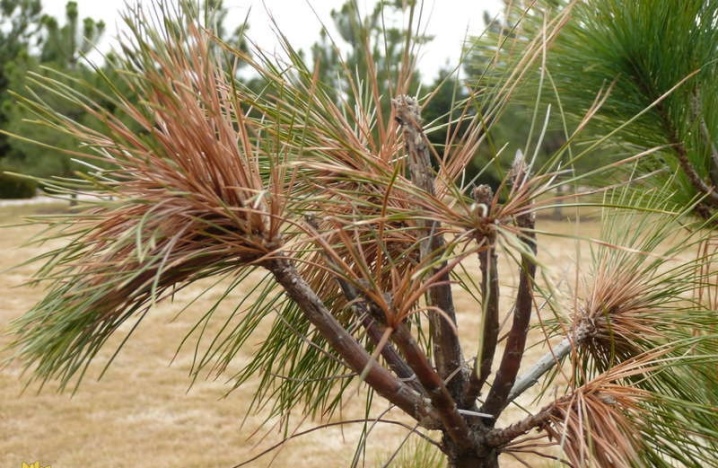
In addition to common fungal diseases, Weymouth pines are often invaded by insect pests. It is worth considering the most common ones.
Spider mite
Arachnid of tiny size. It uses the juice from the needles as food, braiding them with cobwebs, as a result of which the needles turn yellow and crumble. Fighting a tick is very difficult.
It is necessary to process the infected plant at least 5 times with an interval of 7 days. In this case, it is necessary to provide increased humidity.
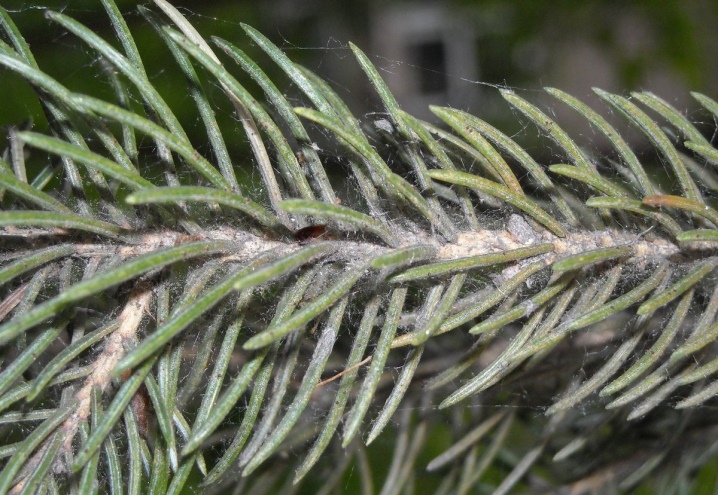
Hermes
One of the types of aphids. If the pine branches are covered with small pieces of "cotton wool", it means that the Hermes settled on them. The needles become yellow, deformed, the plant slows down in growth.
It is necessary to fight these parasites in the spring, when the larvae creep out of the nests, using insecticides, by spraying and injecting into the tree trunk.
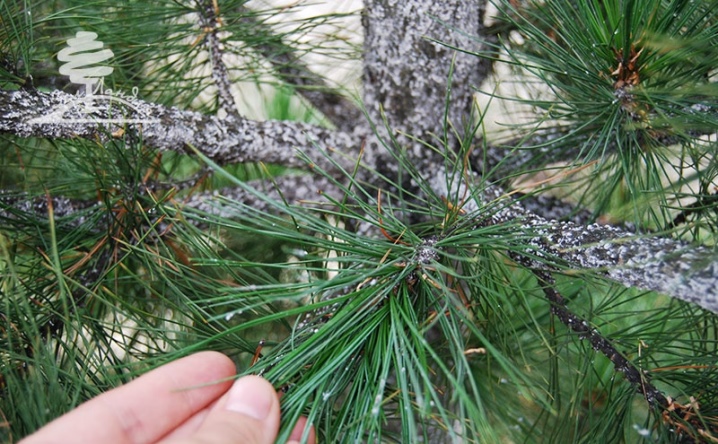
Pine aphid
Small gray insect that feeds on tree sap. The pine needles become gray-purple in color, the tree takes on an unsightly appearance.
Insecticides are used to treat a tree affected by aphids, as well as plants around and nearby anthills.

Pine scoop
A seemingly harmless butterfly. Its larvae are dangerous for trees. Caterpillars gnaw pine buds, shoots, needles.
To get rid of these caterpillars, in the spring, the plant must be sprayed with insecticides based on inhibitors of chitin synthesis.
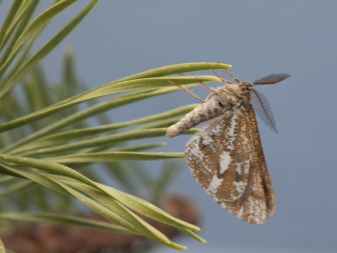

Pine weevil
A small beetle, up to one and a half centimeters long. The weevil imago brings the greatest harm to pines. They gnaw bark, buds, young shoots, needles, as a result of which trees grow twisted and stunted.
This will not happen if the tree is timely treated with chitin synthesis inhibitors, pyrethroids.
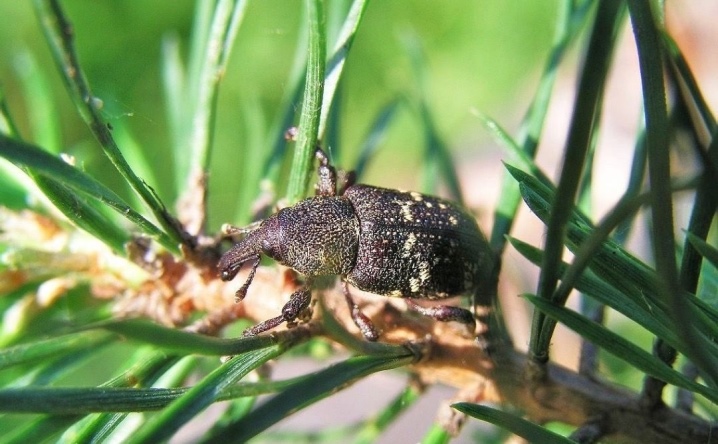
Red pine sawfly
An insect whose larvae cause irreparable damage to conifers. They gnaw the needles clean, damage the bark and shoots.
On small pines, you can manually assemble caterpillars. But if the trees are large, then they should be treated with pyrethroid drugs.
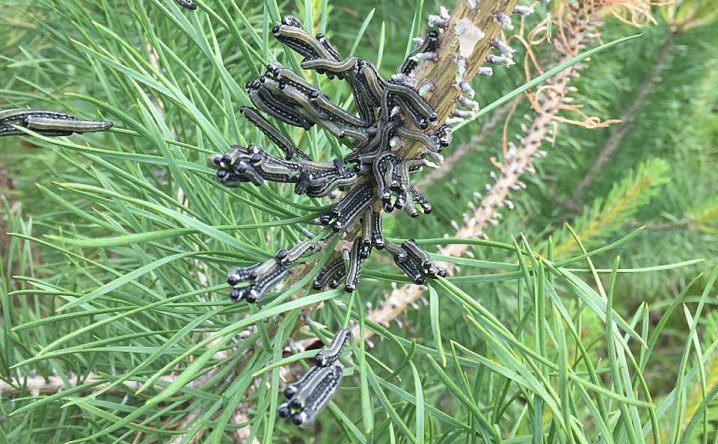
Seeing and correctly eliminating pests in time is no less important task than identifying the disease. It is not uncommon for the owners of the pines, due to their inexperience, to choose the wrong medicine and ruin their plantings.
When identifying pests, be as careful and thoughtful as possible so as not to become a pest for your own plant.
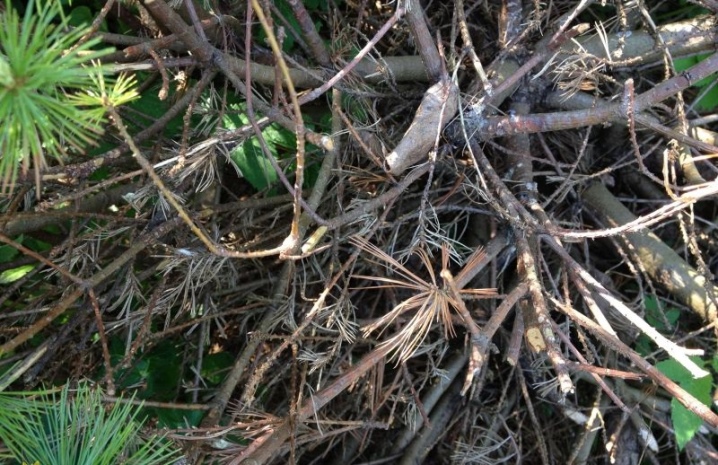
Examples in landscape design
Weymouth pine is becoming more and more popular in landscape design. The variety of shapes and colors of the crown allows you to use it in any corner of the garden area. White pine varieties such as "Ontario", "Louis", "Fastigiata" can be used as solitary trees. Low-growing and creeping forms can be used to decorate alpine slides, rocky gardens. The "Pendula" variety will look favorably against the background of a reservoir. All types of pine trees go well with other plants. With proper care, the Weymouth pine will delight you and your descendants for many decades.

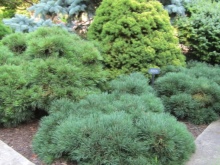
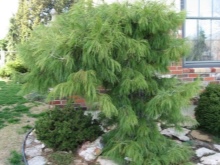
You can find out even more useful and interesting information about Weymouth pine in the next video.



































































The comment was sent successfully.